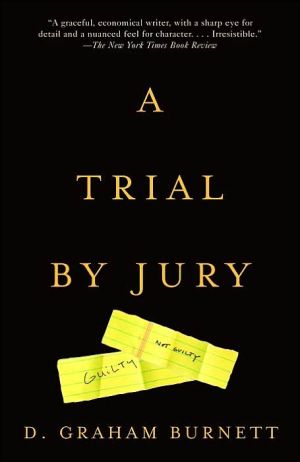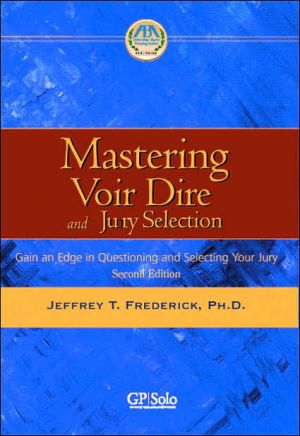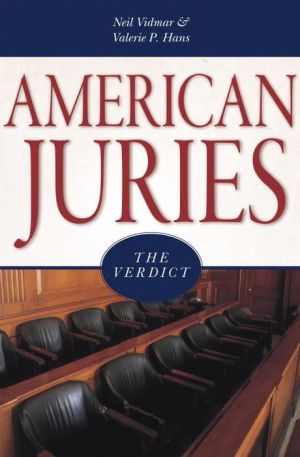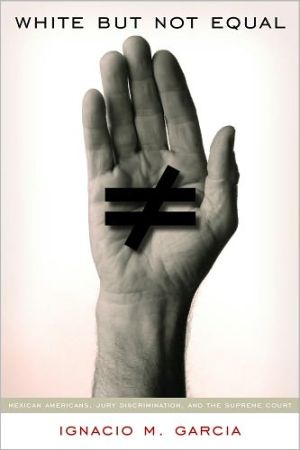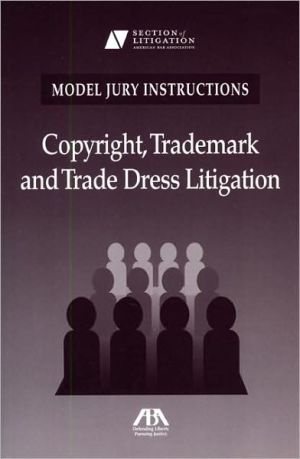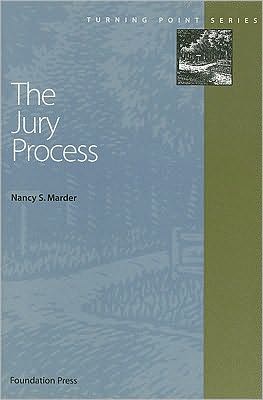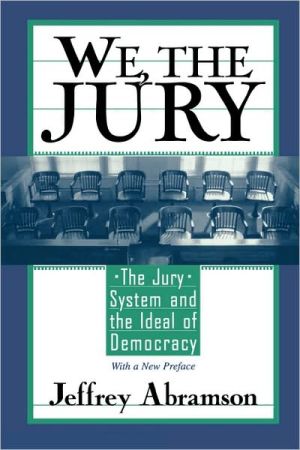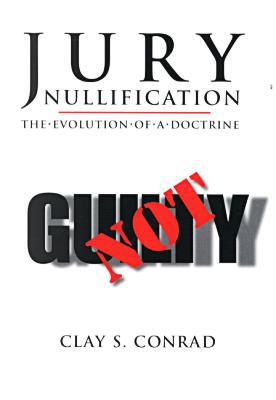A Trial by Jury
When Princeton historian D. Graham Burnett answered his jury duty summons, he expected to spend a few days catching up on his reading in the court waiting room. Instead, he finds himself thrust into a high-pressure role as the jury foreman in a Manhattan trial. There he comes face to face with a stunning act of violence, a maze of conflicting evidence, and a parade of bizarre witnesses. But it is later, behind the closed door of the jury room, that he encounters the essence of the jury...
Search in google:
Jury duty happens to everyone. When the call came to Graham Burnett, a young historian, he had a shock in store. A Trial by Jury is his startling account of how performing this familiar civic duty challenged him in ways he never thought possible and turned into one of the most consuming experiences of his life. Publishers Weekly Combining an ethical examination of civic obligation with a meticulous character study, Princeton historian of science Burnett (Masters of All They Surveyed) dramatizes his experience of being selected for jury duty in a capital case. Told as two parts of the same tale (trial and jury deliberations), the story is appropriately navigated between several Scylla-and-Charybdis pairings the court and the jury room, the truth and lies of the case, the application of laws and the fiery desire for justice. While the murder trial delves into sordid details of transvestism, male prostitution and rape, the tale takes its potent turn when Burnett is unexpectedly moved into the position of jury foreman (the original foreman simply disappeared one day) and must play a critical role in the jury deliberations. Holding other jurors' wide-ranging emotions in check while staying focused on the case himself, Burnett ultimately brings readers face-to-face with the stultifying bureaucracy of American law in praxis. Drawing on an academic and intellectual background, he builds an impressive melodrama and tense, emotionally exhausting scenes in the jury room that surely will recall Twelve Angry Men. But while the ruminations are articulate and engrossing, readers may wonder how Burnett plays a key role in the story while managing to remain distant enough to render the facts of the jury room as easily as he does. (Sept. 19) Forecast: Knopf is taking a big position on this, with a first printing of 100,000, a 10-city author tour and national advertising on CNN and Court TV, where Burnett will also make appearances. If he comes across as personable, his glimpse behind the closed doors of justice could tempt a widerange of curious readers. Copyright 2001 Cahners Business Information.
How It Ended\ I have on my desk at this moment twelve five-by-seven ruled index cards. On each of them the same two words appear: "not guilty." Eight are written in pen, four in pencil. On eight of them the words appear along a single line, on two the words are perpendicular to the ruling, and on two they are scrawled diagonally (one of these last has been written on an inverted card, turned so that the red top line and margin are at the bottom). Three are in all caps, three have only the initial letters capitalized, three are all lowercase, two others show the "N" capitalized but not the "g." In the last of them the word "not" appears in all caps, but the word "guilty" is all lowercase.\ By dint of these varied inscriptions, made in silence in a few tense moments, Monte Virginia Milcray walked out of Part 24 of the New York State Supreme Court, got into the elevator, and descended to the cold wetness of Centre Street a little before noon on February 19, 2000. I preceded him by several minutes, getting into a cab with my duffel bag and riding the dozen blocks home to my wife, with whom I had not spoken in four days. The cards were folded in the breast pocket of my navy blazer. I was crying.\ The twelve cards represent the potent residue of the most intense sixty-six hours of my life, a period during which I served as the foreman of a jury charged to decide whether Monte Milcray was guilty of murdering Randolph Cuffee. During that period, twelve individuals of considerable diversity engaged in a total of twenty-three hours of sustained conversation in a small, bare room. We ran the gamut of group dynamics: a clutch of strangers yelled, cursed, rolled on the floor, vomited, whispered, embraced, sobbed, and invoked both God and necromancy. There were moments when the scene could have passed for a graduate seminar in political theory, others that might have been a jujitsu class. A few came straight out of bedlam. Before it was over, we had spent three nights and four days continuously attended by armed guards (who extended their affable surveillance into all lavatories); we had been shuttled to outlying hotels, into rooms with disconnected phones and sinks in which we washed our clothes; we had watched one juror pulled from our midst and rushed to the hospital (a physical collapse, caused by some combination of missing medication and the crucible of the deliberations), another make a somewhat halfhearted effort to escape (he was apprehended), and a third insist on her right to contact her own lawyer to extricate her from the whole affair (she was threatened with contempt).\ During significant stretches in this trying time, we considered two weeks of testimony in The People of New York v. Monte Virginia Milcray and struggled to understand two things: what happened in Cuffee's apartment on the night of August 1, 1998, and what responsibilities we had as citizens and jurors.\ It is my intention to tell this story as best I can. I am doing so for several reasons, among them two in particular: first, because there are things to be learned from the way events unfolded (about people, about the law, about justice, about truth and how we know it), and, second, because the jury room is a most remarkable--and largely inaccessible--space in our society, a space where ideas, memories, virtues, and prejudices clash with the messy stuff of the big, bad world. We expect much of this room, and we think about it less often than we probably should.\ Before I embark on this task, however, a few words of warning. There are really two stories here: that of the case itself--a trial story, a courtroom story, a drama focused around a violent death; and that of the deliberations--the story of what happened behind the closed door of the jury room. Each of these stories is complex, and they are of course entangled. I set out to write this book in order to tell the latter, but to do so I must rehearse elements of the former. Let me be clear, though: it is by no means my intention to retry the case in a personal memoir. The case is closed. In writing this book, I have made no additional investigations of the events at issue, I have not revisited the records of the trial, and I have not interviewed any of the people involved. All of that was tempting, and would certainly have been interesting, but my sense has been that to embark on such digging would have been, inevitably, to put the trial on trial, to lose myself again in the twisting labyrinth of unrecoverable fact that we negotiated in the jury room. I would have begun to extend that labyrinth, to open new rooms and passages. And this was not the aim. I am sure there is more to the maze than I have seen (when is there not?), but by keeping notes during the weeks of the trial, I laid a thread along the path we took together as jurors, and that is the thread I will follow here.\ A further disclaimer: what I am writing is my own story of the deliberations. I have no idea what those who shared the experience with me would make of this document should they pick it up. Or let me speak more frankly. I am sure each of them would contest my story in different ways--argue, perhaps, I did not represent them rightly; assert that this part over here was not that way; draw to my attention things I have forgotten. If one learns anything from a criminal trial under the adversary system, it is that sincere folk can differ vehemently about events, and that there is seldom any easy way to figure out what actually went on.\ At different moments while writing this account--much of it longhand in a notebook during the weeks following the acquittal--I have closed my eyes and tried to imagine what the small, bare jury room looked like from the perspective of the others. We sat around the same table, but the room must have appeared slightly different to each. I try to see in my mind's eye how things looked from the other side--the door on one's right, the winter windows at one's back.\ That is where Dean Kossler sat. What would he think of this narrative? Dean--the big, solid, former bull-riding cowboy turned vacuum-cleaner repairman. Dean--the six-foot-three-inch born-again God-fearing veteran of the U.S. armed forces. When I first noticed him, in the early days of jury selection, he was spitting tobacco juice behind the radiator by the elevator during a break. He had thin brown hair slicked back and a manly mustache; he wore a weath- ered pair of work boots. A blowhard contractor of some sort, I assumed, and I pegged him, without much thought, as a poster boy for Susan Faludi's tragic tale of the white working-class male--big chest, big gut, big debt. I called him, irreverently, "the Faludiman" in my notes. What did I know? Before the trial ended, he had blown my stereotype (indeed, any stereotype) wide open.\ What would he say about all this? About what I have written?\ Or Felipe Rodriguez? I originally wrote to myself that he seemed "sweet and shy." He giggled often, wore a large number of braided string bracelets, seemed lost in his giant orange parka. I came to loathe him. By the end, he had thrown much into question for me: not least, my confidence in jury trials. Are there some citizens not clearly able to distinguish daytime television from daily life? Apparently there are. Should they participate in deciding on the freedom of another person? Maybe. I doubt he remembers things as I do.\ And there were others, of course. Leah Tennent, the self-possessed and buoyantly bohemian young woman with whom I read Wallace Stevens poems in the back of the bus. Olivelle "Vel" Tover, the youthful, clear-eyed black woman with an elaborate braided coiffure who studied a manual of purgative and rejuvenating fasts in the waiting area; we discussed together the value of self-denial, of cleansing the body through the strictest diets. Rachel Patis, the solid, quiet, unflappable West Indian woman who volunteered at her local police precinct and wore blouses trimmed with lace; she moved slowly, sat very still, seemed like an older lady. Patricia Malley, "Pat," the dyed-blonde tough-girl in the tight black jeans who spoke loudly and much, often well. She seemed instantly animated in Dean's company, adjusted her eyeliner, laughed easily and with gusto.\ And so on: James Lanes (who went by Jim), Jessica Pol- lero, Suzy O'Mear, Paige Barri, and Adelle Benneth. This last, like me, was a professor of history. More improbable still, she focused, as I do, on the history of science, and had, like me, a particular interest in exploration and travel narratives (though she worked on the medieval period and I on the modern). A striking coincidence, all this.\ All together, then, we were two professional histo- rians (Adelle and I), two ad-copy writers (Jessica and Jim), a globe-trotting Gen-X software developer (Leah), an industrial-vacuum-cleaner repairman with a rodeo tattoo who moonlighted in car-stereo installation (Dean), an interior decorator (Paige), an "independent marketing executive" and part-time security guard (Rachel), an actress (Pat, but was she also a bartender?), the manager of certain commercial enterprises owned by the "Mattress King of Miami" (Vel), and a couple of others (Felipe, Suzy) of less clear occupation. Twelve citizens, twelve different characters.\ The deliberations were theirs as much as mine. This story, however, is mine alone. Like a witness, I am fallible; I shall surely misremember things. And even if my memory were perfect, what retelling, in a string of words, is not a distressing distortion of the cluttered thickness of things as they happen?\ Trials are about this.
\ From Barnes & NobleThe Barnes & Noble Review\ Jury duty: Most of us dread it and do anything we can to get out of it. In D. Graham Burnett's provocative account, A Trial by Jury, the author's stint as foreman on a jury deciding a homicide case in New York City becomes a harrowing and eye-opening ordeal, rather than the simple and straightforward civic duty Burnett was expecting. \ Although New York State recently abolished the sequestration of jurors in criminal cases, the rule was still in effect when Burnett and 11 other jurors were asked to decide the fate of a man named Monte Virginia Milcray, accused in the knifing of another man, Randolph Cuffee, in an apartment in Manhattan's Greenwich Village in 1998. Milcray pleaded self-defense, claiming the victim attacked him when a sexual rendezvous went bad.\ The jury was quite diverse, including everything from a restaurant manager to a vacuum cleaner repairman. Burnett, a science historian, was one of two academics in the group. He was not expecting the jury to be sequestered at all. However, the group was ultimately locked away for four long, agonizing, and frustrating days as the various jurors argued over the evidence in the case and conducted numerous laborious reenactments of the murder.\ Burnett, as the foreman, felt the case was not provable, based on the evidence presented by the prosecution; he explains that in a self-defense murder case, the state is required to show beyond a reasonable doubt that the defendant did not commit the act in order to defend him- or herself. He attempts to guide the others into a not guilty verdict, on those grounds, but the jury becomes caught up in petty squabbles, power plays, and attempted escapes from the jury room.\ Ultimately, a verdict is reached, but not before Burnett and the other jurors (and the reader) are dragged through one of the most excruciating -- yet, surprisingly, informative and entertaining -- civics lessons American society has to offer. (Nicholas Sinisi)\ Nicholas Sinisi is the Barnes&Noble.com Nonfiction Editor.\ \ \ \ \ \ Publishers WeeklyCombining an ethical examination of civic obligation with a meticulous character study, Princeton historian of science Burnett (Masters of All They Surveyed) dramatizes his experience of being selected for jury duty in a capital case. Told as two parts of the same tale (trial and jury deliberations), the story is appropriately navigated between several Scylla-and-Charybdis pairings the court and the jury room, the truth and lies of the case, the application of laws and the fiery desire for justice. While the murder trial delves into sordid details of transvestism, male prostitution and rape, the tale takes its potent turn when Burnett is unexpectedly moved into the position of jury foreman (the original foreman simply disappeared one day) and must play a critical role in the jury deliberations. Holding other jurors' wide-ranging emotions in check while staying focused on the case himself, Burnett ultimately brings readers face-to-face with the stultifying bureaucracy of American law in praxis. Drawing on an academic and intellectual background, he builds an impressive melodrama and tense, emotionally exhausting scenes in the jury room that surely will recall Twelve Angry Men. But while the ruminations are articulate and engrossing, readers may wonder how Burnett plays a key role in the story while managing to remain distant enough to render the facts of the jury room as easily as he does. (Sept. 19) Forecast: Knopf is taking a big position on this, with a first printing of 100,000, a 10-city author tour and national advertising on CNN and Court TV, where Burnett will also make appearances. If he comes across as personable, his glimpse behind the closed doors of justice could tempt a widerange of curious readers. Copyright 2001 Cahners Business Information.\ \ \ Library JournalA young scholar with a one-year fellowship at a prestigious New York City learning institution suddenly finds his quiet, bookish life interrupted by jury duty in Manhattan. Burnett (history, Princeton) chronicles his own path from ordinary citizen and prospective juror, to seated juror, to jury foreman, to peacemaker, and, finally, to resolution artist as he uses his own unique blend of knowledge and reason to lead 11 other disparate souls to a unanimous verdict. The book offers rare, insightful views inside a jury room, as people from all walks of life try to work together and reach a consensus. The case at hand involves a complex blend of seduction and murder, with the defendant claiming he killed the victim in self-defense after being pressured for sex. What emerges from the author's leadership of the deliberations is his attempt to build a consensus through a unique blend of patience, knowledge, and wisdom intrinsic to the rigor and discipline of classical and academic thought processes. Burnett reminds us how imperfect the adversarial system of law really is, and the narrative format allows for a rapid and enjoyable overview of the topic. Recommended for academic and public libraries. [Previewed in Prepub Alert, LJ 5/1/01.] Philip Y. Blue, New York State Supreme Court Criminal Branch Lib., New York Copyright 2001 Cahners Business Information.\ \ \ \ \ Kirkus ReviewsAn affecting meditation on jury duty laid out with the dexterity of a police procedural. When intellectual historian and Princeton professor Burnett (Masters of All They Surveyed) receives a juror card during a winter sabbatical, he welcomes it as an improbable vacation into the urban jungle, a whimsy he is disabused of by the coiling process of jury selection alone. The judicial lottery, along with his own scruples, lands him in Part 24 of the New York Supreme Court, its military and religious underpinnings richly evoked, for the murder trial of a young fiance who stabbed a surreptitious date after she turned out to be an unexpectedly domineering transsexual. After listening in open court for several days and spending four more sequestered as foreman with his co-jurors, Burnett gains a more worldly-wise appreciation of the power of the state and the state of things. The episode, he writes, has been a gift that keeps on costing. The gift is compellingly shared with insights that reveal his own self (mindful, intelligent, occasionally pedantic) and the other jurors, all locked in the therapeutic anarchy and political jockeying of their closed room. There, the ancient conflict between legal and moral justice plays out, leading toward a remarkable display of coordinated gravitas at the reading of the verdict. After the trial, evidence highly corroborative to the verdict comes to light; however, Burnett laments, "welcome as the news was, it ransomed our verdict only by bankrupting its logic." He advocates the wisdom of keeping large legal questions open while making decisions based on delimited criteria. Like having one's day in court, reading this revelatory account is a rite of passage that could make any Law and Order hound or legal eagle a more reasonable person.\ \
